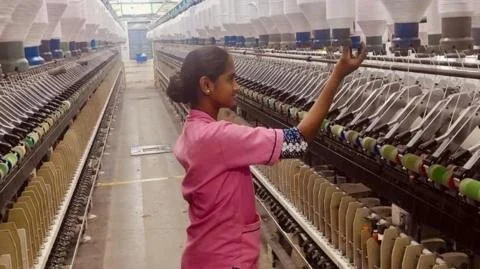Caught in the Crossfire: India's Textile Industry Battles Chinese Dumping Amidst Trade Tensions
The spinning mills of southern India, such as that of 64-year-old Thirunavkarsu, are feeling the adverse effects of increased Chinese imports of viscose yarn, leading to a significant 40% drop in orders from local factories. This situation has arisen as Donald Trump has imposed tariffs between 145% on Chinese goods, prompting Chinese producers to explore alternative markets like India.
Chinese viscose yarn is being sold for 15 rupees ($0.18) less per kilo, severely impacting Indian manufacturers who struggle to compete with these lower prices, which they attribute to the dumping practices of Chinese companies. Jagadesh Chandran of the South India Spinners Association reports that nearly 50 small spinning mills are reducing production.
Despite assurances from China’s Ambassador to India, Xu Feihong, stating that they will not engage in dumping, concerns remain prevalent across various sectors. The flood of inexpensive Chinese goods, from textiles and metals to chemicals, is stressing India’s economy, which relies heavily on Chinese imports—illustrated by a $100 billion trade deficit with China. Moreover, April figures showed a staggering 25% increase in imports, primarily of electronics and raw materials.
India’s trade ministry has responded by forming a committee to monitor cheap imports and has implemented a 12% tax on certain steel imports as protective measures. However, despite efforts to reduce reliance on China through initiatives like the Production Linked Incentive (PLI) scheme, imports continue to grow, highlighting both structural weaknesses in India’s industrial capabilities and a gap in competitiveness.
Economic experts are sounding alarms about the trade imbalance being a warning sign of underlying issues; India’s industrial growth strategies are currently facilitating higher imports rather than boosting domestic production. Nomura cautions that countries experiencing surges in Chinese imports typically see slowdowns in their manufacturing sectors. As global companies look to diversify their supply chains, India’s role remains complex—still dependent on Chinese components.
Experts like Ajay Srivastava emphasize that India must take decisive action and leverage the ongoing trade tensions between the US and China to address these structural challenges to avoid being overwhelmed by cheap goods. Overall, there’s an urgent need for India to reassess its position and engage in meaningful dialogue with China about these trade practices.

